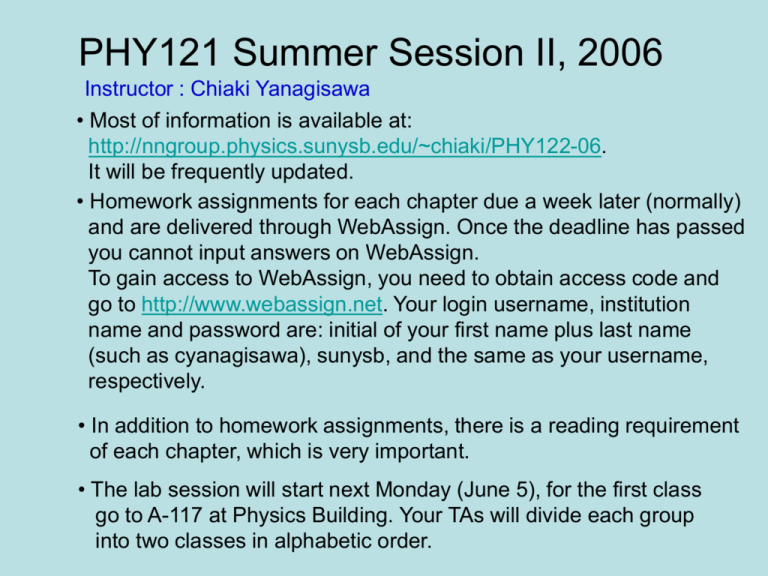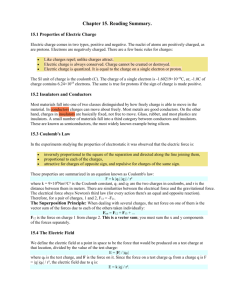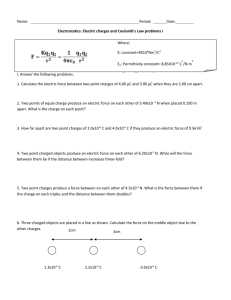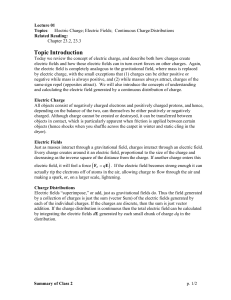Lecture15
advertisement

PHY121 Summer Session II, 2006 Instructor : Chiaki Yanagisawa • Most of information is available at: http://nngroup.physics.sunysb.edu/~chiaki/PHY122-06. It will be frequently updated. • Homework assignments for each chapter due a week later (normally) and are delivered through WebAssign. Once the deadline has passed you cannot input answers on WebAssign. To gain access to WebAssign, you need to obtain access code and go to http://www.webassign.net. Your login username, institution name and password are: initial of your first name plus last name (such as cyanagisawa), sunysb, and the same as your username, respectively. • In addition to homework assignments, there is a reading requirement of each chapter, which is very important. • The lab session will start next Monday (June 5), for the first class go to A-117 at Physics Building. Your TAs will divide each group into two classes in alphabetic order. • There will be recitation classes currently planned to be on Fridays at: 9:30 am - 10:15 am, 10:30 am - 11:15 am 3:00 pm - 3:45 pm, 4:00 pm - 4:45 pm. The location will be announced and the times are subject to change. In the recitation classes, quizzes will be given. • There will be Office Hours by TAs and the times and locations will be announced. • Questions about homework problems should be addressed during Office hours. • Certain important announcements will be announce during the lectures and MOST of THEM (NOT ALL) will be posted on the web. • Find information about which you want to know on the web or during the lectures as much as possible. Chapter 15: Electric Forces and Electric Fields Homework on WebAssign to be set up: 14,22,40,53,64 Properties of electric charges When a plastic rod is rubbed with a piece of fur, the rod is “positively” charged When a glass rod is rubbed with a piece of silk, the rod is “negatively” charged Two equally signed charges repel each other Two opposite signed charges attract each other Electric charge is conserved Electric charge (cont’d) Particle Physics What is the world made of? nucleus Model of Atoms proton Old view electrons eSemi-modern view Modern view quarks nucleus Properties of electric charges Origin of electric charge • Nature’s basic carriers of positive charge are protons, which, along with neutron, are located in the nuclei of atoms, while the basic carriers of negative charge are electrons which orbit around the nucleus of an atoms. Atoms are in general electrically neutral. • It is easier to take off electron(s) from an atom than proton(s). By stripping off an electron from the atom, the atom becomes positively charged, while an atom that the stripped off electron is relocated to becomes negatively charged. • In 1909 Millikan discovered that if an object is charged, its charge is always a multiple of a fundamental unit of charge, designated by the symbol e : the electric charge is quantized. The value of e in the SI unit is 1.60219x10-19 coulomb C. Properties of electric charges Electric charges • Electron: Considered a point object with radius less than 10-18 meters with electric charge e= -1.6 x 10 -19 Coulombs (SI units) and mass me= 9.11 x 10 - 31 kg • Proton: It has a finite size with charge +e, mass mp= 1.67 x 10-27 kg and with radius – 0.805 +/-0.011 x 10-15 m scattering experiment – 0.890 +/-0.014 x 10-15 m Lamb shift experiment • Neutron: Similar size as proton, but with total charge = 0 and mass mn= – Positive and negative charges exists inside the neutron • Pions: Smaller than proton. Three types: + e, - e, 0 charge. – 0.66 +/- 0.01 x 10-15 m • Quarks: Point objects. Confined to the proton, neutron, pions, and so forth. – Not free – Proton (uud) charge = 2/3e + 2/3e -1/3e = +e – Neutron (udd) charge = 2/3e -1/3e -1/3e = 0 – An isolated quark has never been found Properties of electric charges • Two kinds of charges: Positive and Negative • Like charges repel - unlike charges attract • Charge is conserved and quantized 1. Electric charge is always a multiple of the fundamental unit of charge, denoted by e. 2. In 1909 Robert Millikan was the first to measure e. Its value is e = 1.602 x 10−19 C (coulombs). 3. Symbols Q or q are standard for charge. 4. Always Q = Ne where N is an integer 5. Charges: proton, + e ; electron, − e ; neutron, 0 ; omega, − 3e ; quarks, ± 1/3 e or ± 2/3 e – how come? – quarks always exist in groups with the N×e rule applying to the group as a whole. Insulators and Conductors Definition • In conductors, electric charges move freely in response to an electric force. All other materials are called insulators. Insulators : glass, rubber, etc. When an insulator is charged by rubbing, only the rubbed area becomes charged, and there is no tendency for the charge to move into other regions of the material. Conductors : copper, aluminum, silver, etc. When a small area of a conductor is charged, the charge readily distributes itself over the entire surface of the material. Semiconductors : silicon, germanium, etc. Electrical properties of semiconductor materials are somewhere between insulators and conductors. Insulators and Conductors Charging a material • Charging by contact Insulators and Conductors Charging a material • Charging by induction Induction : A process in which a donor material gives opposite signed charges to another material without losing any of donor’s charges Insulators and Conductors Insulator • Polarization • Polarization in an insulator by induction + + - Coulomb’s Law Coulomb’s law - The magnitude of the electric force between two point charges is directly proportional to the product of the charges and inversely proportional to the square of the distance between them F ke r : distance between two charges q1,q2 : charges ke : Coulomb constant 8.9875 x109 Nm/C2 q1q2 r2 - The directions of the forces the two charges exert on each other are always along the line joining them. - When two charges have the same sign, the forces are repulsive. - When two charges have opposite signs, the forces are attractive. F21 q1 q2 q1 q2 q1 q2 + + - - + - r F12 F21 r F12 F21 r F12 Coulomb’s Law Coulomb’s F ke law and units q1q2 r2 r : distance between two charges (m) q1,q2 : charges (C) ke : Coulomb’s constant ke 8.9875 109 N m 2 / C 2 SI unit 8.988 109 N m 2 / C 2 9.0 109 N m 2 / C 2 c 2.99792458 108 m / s ke (10 7 N s 2 / C 2 )c 2 1 40 Exact by definition ; 0 8.854 10 12 C 2 /( N m 2 ) e 1.602176462(63) 1019 C 1 C 106 C, 1 nC 10-9 C charge of a proton Coulomb’s Law Example : Electric forces vs. gravitational forces q 2e 3.2 1019 C electric force q2 Fe 40 r 2 1 2 gravitational force m Fg G 2 r m 6.64 1027 kg q q + + neutron proton r 0 + + 0 a particle Fe 1 q2 9.0 109 N m 2 / C 2 (3.2 1019 C)2 2 Fg 40G m 6.67 1011 N m 2 / kg 2 (6.64 10 27 kg) 2 3.11035 Gravitational force is tiny compared with electric force! Coulomb’s law Example : Forces between two charges q1 25 nC, q2 75 nC + r F21 F12 1 r 3.0 cm F12 q1q2 40 r 2 (25 10 9 C)(75 10-9 C) (9.0 10 N m / C ) (0.030 m) 2 9 0.019 N F21 F12 F21 2 2 Coulomb’s law Superposition of forces Principle of superposition When two charges exert forces simultaneously on a third charge, the total force acting on that charge is the vector sum of the forces that the two charges would exert individually. Example : Vector addition of electric forces on a line F23 q3 F13 + q2 q1 + - 2.0 cm 4.0 cm Coulomb’s Law Example 15.2: May the force be zero Three charges lie along the x-axis as in Fig. The positive charge q1=15 C is at x=2.0 cm, and the positive charge q2=6.0 C is at the origin. Where must a negative charge q3 be placed on the x-axis so that the resultant electric force on it is zero? q2 F23 + q3 - F13 q1 + 2.0 cm-x x 2.0 cm Coulomb’s law Example : Vector addition of electric forces in a plane q1=2.0 C + 0.50 m 0.30 m 0.40 m Q=2.0 C a + 0.30 m 0.50 m + F1Q a q1=2.0 C ( F1Q ) y 1 q1Q 40 r1Q 2 ( F1Q ) x F1Q 0.40m 0.23 N 0.50m 0.30m ( F1Q ) y ( F1Q ) sin a (0.29 N) 0.17 N 0.50m ( F1Q ) x ( F1Q ) cos a (0.29 N) (4.0 10 6 C)(2.0 10-6 C) (9.0 10 N m / C ) (0.50 m) 2 9 2 2 0.29 N Fx 0.23N 0.23N 0.46 N Fy 0.17 N 0.17 N 0 Electric Field Electric A + ++ + + + ++ F0 field and electric forces B q0 + A F0 remove body B + ++ + + + ++ P •Existence of a charged body A modifies property of space and produces an “electric field”. •When a charged body B is removed, although the force exerted on the body B disappeared, the electric field by the body A remains. •The electric force on a charged body is exerted by the electric field created by other charged bodies. Electric Field Electric field and electric forces (cont’d) A A + ++ + + + ++ P placing a test charge + ++ + + + ++ F0 Test charge q0 F0 • To find out experimentally whether there is an electric field at a particular point, we place a small charged body (test charge) at the point. F0 • Electric field is defined by E (N/C in SI units) q0 • The force on a charge q: F qE Electric Field Electric field of apoint charge E q q0 E 0 unit vector P r̂ q rˆ r / r + r̂ S S F0 q P 1 qq0 + 40 r 2 F0 E q0 q0 P r̂ E 1 q rˆ 2 40 r q + ' E r̂ ' S ' rr E E ' E P’ Electric Field Lines An electric field line is an imaginary line or curve drawn through a region of space so that its tangent at any point is in the direction of the electric-field vector at that point. Electric field lines show the direction of E at each point, and their spacing gives a general idea of the magnitude of E at each point. Where E is strong, electric field lines are drawn bunched closely together; where E is weaker, they are farther apart. At any particular point, the electric field has a unique direction so that only one field line can pass through each point of the field. Field lines never intersect. Electric Field Lines Field line drawing rules: • E-field lines begin on + charges and end on - charges. (or infinity) • They enter or leave charge symmetrically. • The number of lines entering or leaving a charge is proportional to the charge. • The density of lines indicates the strength of E at that point. • At large distances from a system of charges, the lines become isotropic and radial as from a single point charge equal to the net charge of the system. • No two field lines can cross. Electric Field Lines Field line examples Electric Field Lines Field line examples (cont’d) Electric Field Lines An electric dipole is a pair of point charges with equal magnitude and opposite sign separated by a distance d. electric dipole moment q qd d Water molecule and its electric dipole q Millikan Oil-Drop Experiment Millikan’s experiment drag force D if v<0 (i.e. Eq<mg) D if v>0 (i.e. Eq>mg) E=0 When the drag force, which is proportional to the velocity of the drop, becomes equal to mg, the drop reaches the terminal velocity. E=0 If the oil drop moves downward, the drag force points upward. When Eq=mg+D, the drop reaches the terminal velocity. Knowing the terminal velocity, mass of the drop, and the magnitude of the electric field, the charge of the drop can be measured. Electric Flux and Guass’s Law Some definitions Closed surface : A closed surface has an inside and outside. Electric flux : A measure of how much the electric field vectors penetrate through a given surface. Electric flux electric flux: A (area) E EA E A Anˆ n̂ : Normal unit vecto r Unit v ector perpendicu lar to the plane A Anˆ electric flux: E EA cos q E A E A q E Calculating Electric Flux n̂3 Example : Electric flux through a cube n̂5 E n̂2 n̂1 n̂4 n̂6 L E1 E nˆ1 A EL2 cos180 EL2 E2 E nˆ2 A EL2 cos 0 EL2 E3 E4 E5 E6 EL2 cos 90 0 E i 1 Ei 0 i 6 Calculating Electric Flux Example : Electric flux through a sphere dA r=0.20 m + +q E E , E // nˆ // dA 3.0 10 6 C E (9.0 10 N m / C ) 2 40 r (0.20m) 2 q 9 2 2 6.75 105 N/C E EA (6.75 105 N/C)(4 )(0.20 m) 2 q=3.0 C A=2r2 3.4 105 N m 2 / C Gauss’s Law Preview: The total electric flux through any closed surface (a surface enclosing a definite volume) is proportional to the total (net) electric charge inside the surface. Case 1: Field of a single positive charge q E A sphere with r=R 1 r=R + q E E surface q E 40 R 2 E EA at r=R 1 q q (4R 2 ) 40 R 0 The flux is independent of the radius R of the surface. Gauss’s Law Case 2: More general case with a charge +q E A E n E E cos E A q (A) cos q + q + surface perpendicular to E E E A E cosqA E q 0 Gauss’s Law Case 3: An closed surface without any charge inside E 0 Electric field lines that go in come out. Electric field lines can begin or end inside a region of space only when there is charge in that region. + Gauss’s law E Qinside 0 ; Qinside i qi , E i Ei The total electric flux through a closed surface is equal to the total (net) electric charge inside the surface divided by 0 Applications of Gauss’s Law Example 15.8: Field of an infinite plane sheet of charge E the sheet E E : charge density E + + + Qinside A E + E 2( EA) + + + + + + + E 2 0 Gaussian surface Note: Ex 2 0 Ex 2 0 x0 x0 two end surfaces A 0 Gauss’s Law Example : Field between oppositely charged parallel conducting plane plate 1 E1 E 2 + b + a + S1 + + + + S2 + + E1 E2 E plate 2 Solution 1: - E 2 E1 c - S - 4 S3 - No electric flux on these surfaces A S1 : EA E (right surface) 0 0 outward flux E0 (left surface) A S 4 : EA E (left surface) inward flux 0 E0 0 (right surface) Solution 2: At Point a : E1 E2 E E1 E2 0 b : E1 E2 E 2 2 0 0 c: E1 E2 E E1 E2 0 Application of Gauss’s Law Trajectory of a charged particle in a uniform electric field Applications of Gauss’s Law Example : Field of an infinite line of charges Gaussian surface E , E E dA chosen according to symmetry line charge density Qencl E E on the cylindrica l Gaussian surface E E (2 r) E 1 20 r 0 Applications of Gauss’s Law Example : Field of a uniformly charged sphere Gaussian surface 4 3 charge density r R : EA ( r ) / 0 + + 3 4 3 2 Q + E ( 4 r ) ( r ) / 0 + + + + 4 3 +r=R R 3 3 1 Qr + + E + 40 R 3 1 Q r R: E 40 R 2 Q 2 R r : E (4 r ) R 0 + 1 Q E 40 r 2 Applications of Gauss’s Law Example 15.7 : Field of a charged spherical shell Gaussian surface + + b + + r a : EA E (4 r ) + 2 + a + + Total charge on the shell = Q b r : E (4 r ) 2 Qinside 0 Qinside 0 Q 0E 0 1 Q E 0 40 r 2 Applications of Gauss’s Law Charge distribution and field • The charge distribution the field • The symmetry can simplify the procedure of application Electric field by a charge distribution on a conductor • When excess charge is placed on a solid conductor and is at rest, it resides entirely on the surface, not in the interior of the material (excess charge = charge other than the ions and free electrons that make up the material conductor A Gaussian surface inside conductor Charges on surface Conductor Applications of Gauss’s Law Electric field by a charge distribution on a conductor (cont’d) A Gaussian surface inside condactor Charges on surface Conductor E at every point in the interior of a conducting material is zero in an electrostatic situation (all charges are at rest). If E were non-zero, then the charges would move • Draw a Gaussian surface inside of the conductor • E=0 everywhere on this surface (inside conductor) Gauss’s law • The net charge inside the surface is zero • There can be no excess charge at any point within a solid conductor • Any excess charge must reside on the conductor’s surface • E on the surface is perpendicular to the surface Charges on Conductors Case 1: charge on a solid conductor resides entirely on its outer surface in an electrostatic situation + + + + + + + + + ++ + ++ + + The electric field at every point within a conductor is zero and any excess charge on a solid conductor is located entirely on its surface. Case 2: charge on a conductor with a cavity + + + + + + + + + ++ + ++ + + If there is no charge within the cavity, the net charge on the surface of the cavity is zero. Gauss surface Charges on Conductors Case 3: charge on a conductor with a cavity and a charge q inside the cavity + + + + + - - + + - + - + + - - + + ++ + ++ Gauss surface • The conductor is uncharged and insulated from charge q. • The total charge inside the Gauss surface should be zero from Gauss’ law and E=0 on this surface. Therefore there must be a charge –q distributed on the surface of the cavity. • The similar argument can be used for the case where the conductor originally had a charge qC. In this case the total charge on the outer surface must be q+qC after charge q is inserted in cavity.







